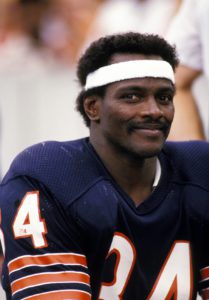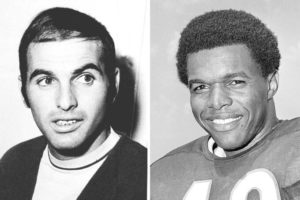Looking Back at Legendary Chicago Bears Football Players Gale Sayers (1943 – 2020), Brian Piccolo (1943 – 1970) & Walter Payton (1954 -1999)
[AdSense-A]
Baseball may be America’s Pastime by perception, but there is a popularity that is unmatched by the National Football League. From the time of its inception here in America, it was the definition of not only a “man’s game” from the physical aggressiveness as part of play, but the also the ultimate team game.
While an NFL roster is filled by 53 players, each segment of the game is broken up by 11 players on the field per team at a time. The potential strategy filled chess game lines 11 men on the offensive side of the ball matched against 11 men on the defensive side of the ball. The objective seems so simple: offensively drive the ball to the finish line to score. The defense objective cannot be simpler: DO NOT LET THE OFFENSE BRING THE BALL ACROSS THE GOAL LINE.
Up front, like warfare, you have a battle between the big bodied soldiers. Those linemen can be the greatest unsung heroes or the blame for failure. In the history of the Chicago Bears, their play was as volatile as the stock market. That inconsistent, though more “bearish” quality of play by the linemen, allowed a spotlight to some of the greatest offensive specialty players in running backs in NFL history.
Sure, there were good running backs across the leagues history that deserve plenty of recognition. Jim Brown, Barry Sanders, Emmitt Smith, Eric Dickerson and Earl Campbell stand as historic names at the position. However, two names really pave the way for the discussions of the greatest all time running backs, and they both picked the City of Broad Shoulders up and carried it on their backs.
While the NFL lost a legend this week in Gale Sayers, was a leading example of perseverance that arguably puts him in this category. Sayers came to the Bears out of the draft from Kansas. His perseverance was dominating on and off the field, though it is the on-field play that earned him the nicknames, “Black Magic” and “The Kansas Comet.” Sayers would explode in his injury shortened career for a season record of 22 touchdowns in his rookie season that remained unbroken until OJ Simpson broke it with 23 in the following decade. The impact of Sayers in the NFL resulted with an induction to the NFL Hall of Fame after only playing 6 seasons due to knee injuries. He ended with just under 5,000 total rushing yards and 47 total touchdowns. He paved the way for outstanding play in a short period of time to be considered a game changing icon in the game, which allowed for a more modern-day Barry Sanders path to the HoF.
Like many people, the current situation tends to be overlooked with eyes in the past or a vision to the future. His time in Chicago as a Bear was brought to life by the famed story of Brian’s Song. A rookie in 1965, Sayers was an African American in a major metropolitan city during the Civil Rights Movement. People do not realize the magnitude of this timeframe, even in the common love of sport. To make things a little more complex, Coach George Halas assigned Sayers and fellow rookie running back Brian Piccolo as roommates while on the road. Piccolo, drafted out of Wake Forest, was very truthfully portrayed as a kindhearted competitor. Falling behind Sayers, who was once again put in front of Piccolo as far as depth chart (referring to rankings while the two were in college at the position), the bond Piccolo and Sayers had helped set the example and pave the way for further integration within the sector of a team within the NFL.
The story of Brian Piccolo is a phenomenal tear-jerking one in itself. His relationship with Sayers helped both men push to be the absolute best they could be at the running back position. In many ways they resembled the odd couple. Aside from Piccolo being white and Sayers black, Piccolo was a very outgoing jovial personality. Sayers was as shy as can be. It was Piccolo who helped drive Sayers back after injury. Knee injuries, while always serious, were far more damning back in this era. The number of careers that were ended prematurely by injury during this time were a very common tragic tale. Sayers still only had 6 seasons due to injury, where during the modern era, a talent like Sayers may have gone on for longer. Piccolo helped push Sayers to his return and his dominance along with it. Piccolo died from cancer at the age of 26 in 1970, but the legacy of the relationship and bond with Sayers continues to live on and should be in the spotlight with the current social climate in the world today.
While Piccolo and Sayers played on some teams that had ups and downs on the field and changed the light of inter-racial co-existence in the NFL, the way was paved for arguably the greatest running back of all time. The city of Chicago was blessed to have the ability to call Walter Payton a son. Payton brought levels of excitement to the Windy City that were unmatched until Michael Jordan ended up in full flight. Payton had played on several Bears teams of poor quality and limited successes in the wins column.
The constant attempt to build around the future Hall of Famer was slow and proved to be painful. The lack of support made Payton the focal point of the Bears offense, creating the large target on his back for opposing defenses. Payton would often find himself cornered by defenders, but channeling his inner Sayers, would find his way out of check mate status. His capability to turn nothing into large gains was arguably greater than Sayers, who made a career off the concept of “just give me 18 inches of day light” (to run through). The tougher the challenge of increased pressure to do it almost all alone would prove to be a task Payton was up to, no matter the cost. Through seasons of almost tireless beatings, Payton would eclipse to be the NFL’s All Time Leading Rusher with 16,726 yards from scrimmage. He would hold that record after retiring in 1987 completing 12 seasons on the south side of Chicago. Just a couple seasons before his retirement, the Bears had finally put together a string of winning seasons that allowed for him to not only step away as the focal point and be more strategically used, but helped the Bears attain their first Super Bowl in franchise history- and only to date.
Nicknamed “Sweetness,” Payton played the game like the definition of a man’s man. He played with a “never die easy” motto. With zero fear with each snap, Payton was more driven to dish out the punishment than he was concerned with getting hit. His drive from an intrinsic fear of  failure and chip on his shoulder to show he would not be beat. The leadership and legacy of Walter Payton goes beyond the NFL, identifying as an athletic icon. The training videos of Payton running up what is now known as “Payton’s Hill” was a direct reminder of how he played. Always enduring until he got to the top of the mountain. Enduring more physical adversity on the football field than arguably anyone, continued to drive his relentless pursuit of excellence. Was he the biggest or fastest in a position that would desire those traits? No, but he was the smartest and toughest, and his God given talent was nothing short of believed to be the reason he was put on this earth. In a position that showed an average career span of 5 seasons, he dominated for 12 retiring at the age of 33.
failure and chip on his shoulder to show he would not be beat. The leadership and legacy of Walter Payton goes beyond the NFL, identifying as an athletic icon. The training videos of Payton running up what is now known as “Payton’s Hill” was a direct reminder of how he played. Always enduring until he got to the top of the mountain. Enduring more physical adversity on the football field than arguably anyone, continued to drive his relentless pursuit of excellence. Was he the biggest or fastest in a position that would desire those traits? No, but he was the smartest and toughest, and his God given talent was nothing short of believed to be the reason he was put on this earth. In a position that showed an average career span of 5 seasons, he dominated for 12 retiring at the age of 33.
In one of the most relentlessly physical sports in one of the most sports critical cities, the Chicago Bears shined in a position that requires the toughness both physically and mentally. Being home to two icons in all of sports history, we remember the hell both had to endure to succeed. We remember the joy of the winning moments through championships and records. Most of all, this past week, we feel the sadness from the loss of Gale Sayers and remember the tears competitors all over the world felt in 1999 with the early loss of Walter Payton. They’re battles on the gridiron and trajectory to the impact they had in other areas of the world will forever be felt.
[si-contact-form form=’2′]


